The smart welding monitoring solution market is set to grow from USD 1,239.7 million in 2025 to USD 2,283.8 million by 2035, reflecting a CAGR of 6.3%. The market demonstrates clear phases of acceleration and deceleration shaped by adoption patterns, technological improvements, and regional deployment. From 2025 to 2028, growth accelerates as manufacturers in automotive, shipbuilding, aerospace, and heavy machinery adopt smart monitoring solutions to improve weld quality, reduce defects, and increase operational efficiency. Early adoption is supported by integration with digital manufacturing systems and real-time analytics, producing a sharp upward trend in the market curve.
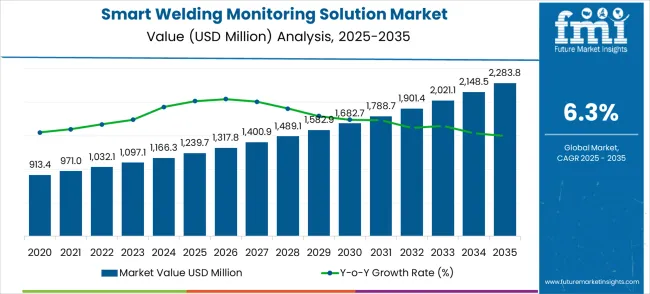
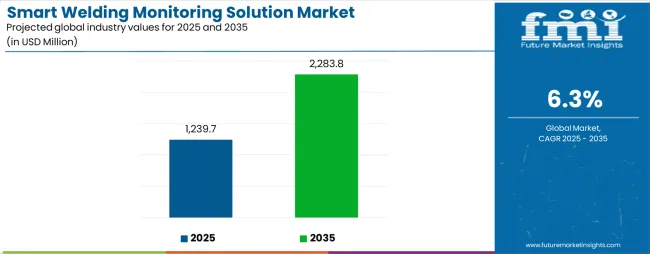
Between 2028 and 2032, growth decelerates slightly as early adopters reach full-scale deployment, with incremental expansion coming from system upgrades, replacements, and adoption in mid-sized industrial operations. The pace moderates but remains positive as the technology becomes more widespread. From 2032 to 2035, acceleration resumes with investment from emerging regions and new industrial players. Enhancements such as AI-driven analytics, cloud-based monitoring, and predictive maintenance boost adoption. The acceleration and deceleration pattern illustrates a market that experiences initial rapid growth, a mid-period stabilization, and renewed expansion in the latter phase, providing a roadmap for manufacturers to align production, technology development, and market deployment strategies over the decade.
Recent innovations include real-time monitoring systems, AI-driven defect detection, and IoT-enabled process control. Manufacturers are introducing modular, wireless, and cloud-connected solutions to improve traceability and efficiency. Expansion into automated production lines, remote inspection, and smart factories is driving adoption. Collaborations between solution providers and industrial OEMs enable customized monitoring systems for accuracy, process optimization, and quality assurance, supporting consistent market growth worldwide.
The market for smart welding monitoring solutions is distributed across automotive manufacturing (35%), heavy machinery and construction equipment (25%), shipbuilding and marine fabrication (15%), aerospace and defense manufacturing (12%), and specialized industrial applications such as oil and gas pipelines (13%). Automotive manufacturing leads adoption due to the demand for consistent weld quality, reduced defects, and automation integration. Heavy machinery and construction equipment manufacturers deploy monitoring solutions to ensure structural integrity in high-stress components. Shipbuilding and marine fabrication rely on these systems for corrosion-resistant and precision welds, while aerospace and defense industries implement them for safety-critical assemblies. Specialty industrial applications focus on pipeline, pressure vessel, and energy infrastructure welding quality.
| Metric | Value |
|---|---|
| Market Value (2025) | USD 1,239.7 million |
| Market Forecast Value (2035) | USD 2,283.8 million |
| Forecast CAGR (2025 to 2035) | 6.3% |
Market expansion is being supported by the rapid advancement of industrial automation across developing economies and the corresponding need for intelligent monitoring systems for welding quality assurance in manufacturing facilities. Modern welding operations require precise process monitoring and defect detection to ensure optimal product quality and operational efficiency. The superior monitoring capabilities and real-time analysis characteristics of smart welding monitoring solutions make them essential systems in demanding manufacturing environments where welding quality is critical.
The growing emphasis on quality control and operational efficiency is driving demand for advanced monitoring technologies from certified manufacturers with proven track records of reliability and accuracy. Manufacturing operators are increasingly investing in high-quality monitoring systems that offer real-time analysis and predictive maintenance capabilities over extended production periods. Quality standards and industry certifications are establishing performance benchmarks that favor precision-engineered smart welding monitoring solutions with advanced analytical capabilities.
The market is segmented by solution type, application, and region. By solution type, the market is divided into real-time monitoring systems, IoT-integrated platforms, welding management software, and others. Based on application, the market is categorized into automotive, aerospace, construction, shipbuilding, energy sector, and others. Regionally, the market is divided into North America, Europe, East Asia, South Asia & Pacific, Latin America, and Middle East & Africa.
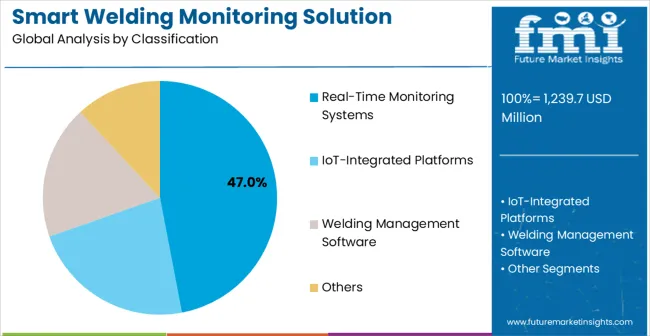
Real-time monitoring systems are projected to account for 47% of the smart welding monitoring solution market in 2025. This leading share is supported by the increasing demand for immediate quality feedback in manufacturing applications and growing requirements for continuous process monitoring. Real-time monitoring systems provide instantaneous weld quality assessment and process optimization, making them the preferred choice for automotive production lines, aerospace manufacturing, and critical infrastructure applications. The segment benefits from technological advancements that have improved the accuracy and responsiveness of real-time monitoring systems while reducing implementation complexity.
Modern real-time monitoring systems incorporate advanced sensors, high-speed data processing, and sophisticated algorithms that enable immediate defect detection and process adjustment. These innovations have significantly improved welding quality while reducing total cost of ownership through prevention of defective welds and elimination of rework costs. The automotive and aerospace sectors particularly drive demand for real-time monitoring solutions, as these industries require absolute quality assurance to maintain product integrity and comply with stringent safety standards.
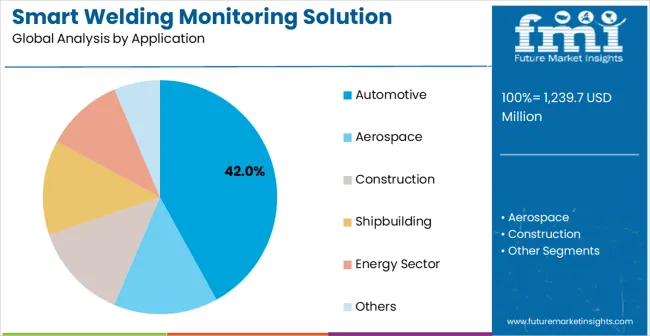
Automotive applications are expected to represent 42% of smart welding monitoring solution demand in 2025. This dominant share reflects the critical role of welding quality in automotive manufacturing and the need for robust monitoring solutions capable of ensuring consistent weld quality in high-volume production environments. Automotive manufacturing facilities require effective and reliable monitoring systems for body-in-white assembly, chassis welding, and component fabrication. The segment benefits from ongoing expansion of automotive production in developing countries and increasing quality requirements demanding enhanced monitoring systems in vehicle manufacturing facilities.
Automotive manufacturing operations demand exceptional monitoring performance to ensure vehicle safety and regulatory compliance. These applications require systems capable of handling high production speeds, multiple welding processes, and continuous operation in demanding manufacturing conditions. The growing emphasis on automotive safety standards, particularly in electric vehicle manufacturing and lightweight material applications, drives consistent demand for high-performance welding monitoring solutions. Emerging markets in Asia-Pacific, Latin America, and European regions contribute significantly to market growth as automotive manufacturers invest in modern monitoring technologies to improve production quality and efficiency.
The smart welding monitoring solution market is advancing rapidly due to increasing manufacturing automation and growing recognition of quality control technology importance. The market faces challenges including high system integration costs, need for specialized technical expertise, and varying monitoring requirements across different welding applications. Standardization efforts and certification programs continue to influence technology quality and market development patterns.
The growing deployment of AI-powered analysis systems and machine learning algorithms is enabling predictive quality assessment and automated process optimization capabilities in smart welding monitoring installations. Advanced analytics and intelligent decision-making systems provide continuous learning from welding data while optimizing process parameters and extending equipment performance. These technologies are particularly valuable for complex manufacturing facilities that require adaptive monitoring performance and minimal human intervention.
Modern monitoring solution manufacturers are incorporating cloud connectivity and Industry 4.0 integration technologies that enable remote monitoring capabilities while facilitating data analytics and process optimization through connected manufacturing systems. Integration of edge computing and advanced communication protocols enables comprehensive data management and significant operational insights compared to traditional standalone monitoring systems. Advanced software platforms and connectivity solutions also support development of more integrated and scalable monitoring architectures for demanding industrial environments.
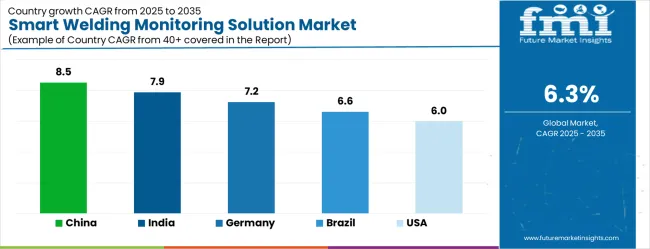
| Country | CAGR (2025-2035) |
|---|---|
| China | 8.5% |
| India | 7.9% |
| Germany | 7.2% |
| Brazil | 6.6% |
| United States | 6.0% |
| United Kingdom | 5.4% |
| Japan | 4.7% |
The smart welding monitoring solution market is growing rapidly, with China leading at an 8.5% CAGR through 2035, driven by massive manufacturing automation expansion, industrial digitalization programs, and smart factory development. India follows at 7.9%, supported by rising manufacturing investments and increasing adoption of automated quality control systems in welding operations. Germany records strong growth at 7.2%, emphasizing precision engineering, Industry 4.0 implementation, and advanced manufacturing capabilities. Brazil grows steadily at 6.6%, integrating smart monitoring systems into expanding automotive and industrial manufacturing facilities. The United States shows moderate growth at 6.0%, focusing on technology innovation and manufacturing modernization improvements. The United Kingdom maintains steady expansion at 5.4%, supported by industrial automation programs. Japan demonstrates stable growth at 4.7%, emphasizing technological innovation and manufacturing excellence.
The report covers an in-depth analysis of 40+ countries, Top-performing countries are highlighted below.
The market for smart welding monitoring solutions in China is expanding at a CAGR of 8.5%, above the global average. Growth is driven by automated welding adoption in automotive, shipbuilding, and industrial equipment sectors. Advanced monitoring systems provide real-time defect detection, improve process control, and boost production efficiency. Industrial clusters and high-tech manufacturing zones integrate IoT-enabled welding systems to optimize throughput. Pilot programs demonstrate reduced rework and improved material handling. Suppliers focus on scalability, predictive maintenance, and software integration for high-volume production. Collaboration with research institutions advances sensor technology and monitoring algorithms, enabling reliable operation in demanding manufacturing conditions.
India is expected to grow at a CAGR of 7.9%, above the global average. Growth is fueled by adoption in construction equipment, automotive, and industrial fabrication industries. Smart monitoring systems track weld quality, reduce scrap, and automate maintenance schedules. Industrial hubs deploy these solutions for both large-scale and small-scale production facilities. Pilot installations show increased efficiency, fewer defects, and faster cycle times. Suppliers provide cost-effective, precise systems suitable for high-volume manufacturing. Public-private partnerships enhance skill development and technology adoption, supporting wider implementation across regional industrial clusters.
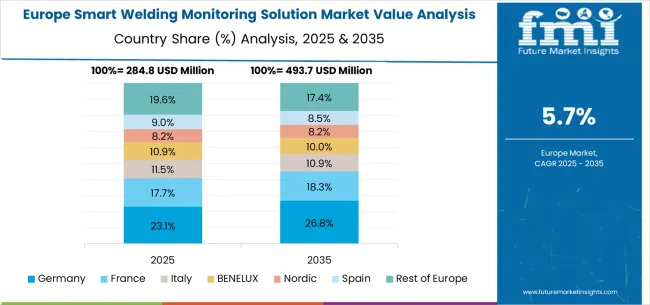
Germany grows at a CAGR of 7.2%, above the global average. Growth is driven by automotive, aerospace, and industrial equipment sectors requiring high-accuracy welding processes. Smart monitoring solutions are applied for real-time quality checks, defect detection, and process optimization. Suppliers provide energy-efficient systems with precise controls and long-term reliability. Industrial collaborations improve defect detection algorithms and sensor performance. Pilot installations reduce material waste and increase production throughput. Regulatory requirements for safety and quality drive adoption in high-value manufacturing lines.
The Brazilian market grows at a CAGR of 6.6%, slightly above the global average. Adoption is supported by shipbuilding, automotive, and industrial fabrication industries. Smart monitoring solutions improve weld quality, process efficiency, and reduce downtime. Industrial clusters integrate these systems to increase throughput and maintain consistent production. Suppliers offer durable solutions suitable for tropical conditions and high-volume manufacturing. Pilot projects demonstrate enhanced precision and reduced operational delays. Local training programs and distributor support improve deployment efficiency, while regional research initiatives refine sensor accuracy and analytics for welding operations.
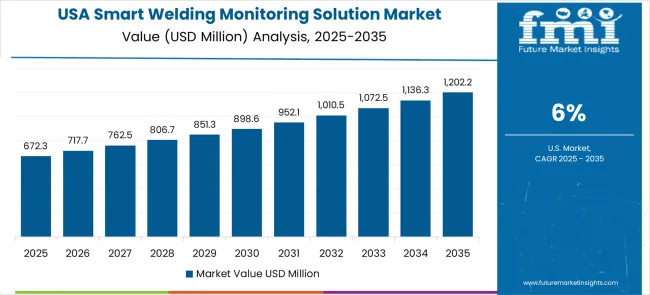
The United States grows at a CAGR of 6.0%, slightly below the global average. Growth is moderated by mature infrastructure and existing adoption of automated welding systems. Smart monitoring solutions are applied in automotive, aerospace, and industrial sectors to reduce defects and improve productivity. Suppliers provide high-reliability systems with precise control and predictive maintenance features. Pilot projects show fewer defects, higher throughput, and optimized resource use. Industrial hubs implement monitoring across multiple production lines for better operational performance. R&D continues to refine sensor accuracy, process analytics, and energy efficiency.
The UK market grows at a CAGR of 5.4%, below the global average. Slower adoption is due to limited expansion of manufacturing facilities and reliance on imported technology. Systems are used in automotive, shipbuilding, and specialized industrial operations. Suppliers provide reliable, precise machines that integrate with existing production lines. Pilot installations demonstrate higher weld quality, reduced rework, and improved operational efficiency. Industrial clusters gradually deploy monitoring solutions, focusing on high-value production and research applications. Training programs help operators achieve optimal system performance.
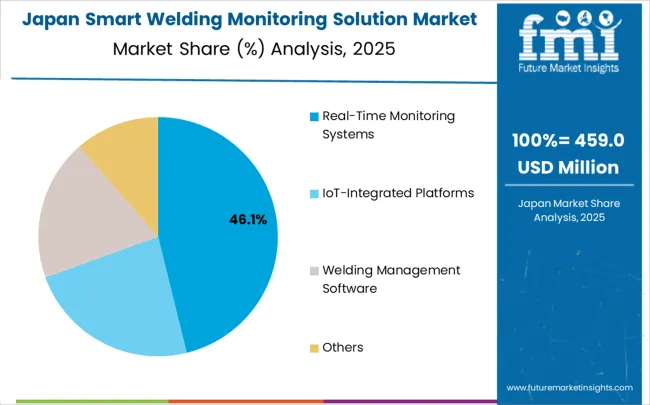
Japan grows at a CAGR of 4.7%, below the global average. Slower growth results from a mature industrial sector and limited new adoption. Smart monitoring solutions are applied in automotive, electronics, and industrial production for process improvement. Suppliers provide durable, precise systems suitable for high-value applications. Pilot programs show improved weld consistency and reduced downtime. Industrial clusters integrate monitoring solutions into automated lines for better workflow. R&D initiatives continue to enhance sensor accuracy, process analytics, and operational reliability in demanding environments.
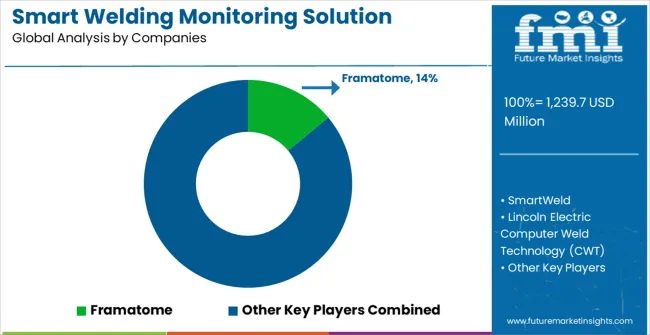
The smart welding monitoring solution market is defined by competition among established industrial automation manufacturers, specialized welding technology companies, and emerging IoT solution providers. Companies are investing in advanced sensor technologies, artificial intelligence integration, standardized quality systems, and technical support capabilities to deliver reliable, intelligent, and cost-effective monitoring solutions. Strategic partnerships, technological advancement, and geographic expansion are central to strengthening product portfolios and market presence.
Framatome, operating globally, offers comprehensive welding monitoring solutions with focus on precision measurement, reliability, and technical support services. SmartWeld, specialized provider, delivers innovative monitoring systems with emphasis on real-time analysis and application integration capabilities. Lincoln Electric, multinational manufacturer, provides advanced monitoring technologies with focus on welding process optimization and system integration. Computer Weld Technology (CWT) offers comprehensive monitoring solutions with standardized procedures and technical service support.
Lorch provides industrial welding monitoring systems with emphasis on advanced technology and technical expertise. Megmeet delivers specialized monitoring equipment with focus on high-performance industrial applications. Cavitar, Novarc Technologies, Fronius offer comprehensive monitoring technologies for demanding manufacturing environments with established development and service capabilities.
VITRONIC, ESAB, KUKA, DAIHEN Corporation, Xiris Automation, Precitec GmbH, and TWI Ltd provide advanced monitoring systems with global manufacturing capabilities, regional service networks, and specialized expertise across industrial automation and welding technology sectors.
The smart welding monitoring solution market underpins manufacturing quality excellence, industrial automation advancement, production efficiency optimization, and Industry 4.0 implementation. With automation mandates, stricter quality requirements, and demand for real-time monitoring systems, the sector must balance cost competitiveness, technology reliability, and integration capabilities. Coordinated contributions from governments, industry bodies, OEMs/technology integrators, suppliers, and investors will accelerate the transition toward AI-powered, cloud-connected, and digitally integrated smart welding monitoring systems.
| Item | Value |
|---|---|
| Quantitative Units | USD 1,239.7 million |
| Solution Type | Real-Time Monitoring Systems, IoT-Integrated Platforms, Welding Management Software, Others |
| Application | Automotive, Aerospace, Construction, Shipbuilding, Energy Sector, Others |
| Regions Covered | North America, Europe, East Asia, South Asia & Pacific, Latin America, Middle East & Africa |
| Country Covered | United States, Germany, India, China, United Kingdom, Japan, Brazil, and other 40+ countries |
| Key Companies Profiled | Framatome, SmartWeld, Lincoln Electric, Computer Weld Technology (CWT), Lorch, Megmeet, Cavitar, Novarc Technologies, Fronius, VITRONIC, ESAB, KUKA, DAIHEN Corporation, Xiris Automation, Precitec GmbH, TWI Ltd |
| Additional Attributes | Dollar sales by solution type and application segments, regional demand trends across North America, Europe, and Asia-Pacific, competitive landscape with established manufacturers and emerging technology suppliers, buyer preferences for real-time versus predictive monitoring systems, integration with industrial IoT and Industry 4.0 technologies, innovations in sensor technology and artificial intelligence for enhanced accuracy and predictive capabilities, and adoption of cloud-connected monitoring solutions with embedded analytics and remote monitoring capabilities for improved operational efficiency. |
The global cleanroom and lab surface contamination control products market is estimated to be valued at USD 1,056.4 million in 2025.
The market size for the cleanroom and lab surface contamination control products market is projected to reach USD 1,519.2 million by 2035.
The cleanroom and lab surface contamination control products market is expected to grow at a 3.7% CAGR between 2025 and 2035.
The key product types in cleanroom and lab surface contamination control products market are sticky/tacky mats, cleanroom flooring systems and others.
In terms of application, semiconductors and electronics segment to command 35.0% share in the cleanroom and lab surface contamination control products market in 2025.






Our Research Products

The "Full Research Suite" delivers actionable market intel, deep dives on markets or technologies, so clients act faster, cut risk, and unlock growth.

The Leaderboard benchmarks and ranks top vendors, classifying them as Established Leaders, Leading Challengers, or Disruptors & Challengers.

Locates where complements amplify value and substitutes erode it, forecasting net impact by horizon

We deliver granular, decision-grade intel: market sizing, 5-year forecasts, pricing, adoption, usage, revenue, and operational KPIs—plus competitor tracking, regulation, and value chains—across 60 countries broadly.

Spot the shifts before they hit your P&L. We track inflection points, adoption curves, pricing moves, and ecosystem plays to show where demand is heading, why it is changing, and what to do next across high-growth markets and disruptive tech

Real-time reads of user behavior. We track shifting priorities, perceptions of today’s and next-gen services, and provider experience, then pace how fast tech moves from trial to adoption, blending buyer, consumer, and channel inputs with social signals (#WhySwitch, #UX).

Partner with our analyst team to build a custom report designed around your business priorities. From analysing market trends to assessing competitors or crafting bespoke datasets, we tailor insights to your needs.
Supplier Intelligence
Discovery & Profiling
Capacity & Footprint
Performance & Risk
Compliance & Governance
Commercial Readiness
Who Supplies Whom
Scorecards & Shortlists
Playbooks & Docs
Category Intelligence
Definition & Scope
Demand & Use Cases
Cost Drivers
Market Structure
Supply Chain Map
Trade & Policy
Operating Norms
Deliverables
Buyer Intelligence
Account Basics
Spend & Scope
Procurement Model
Vendor Requirements
Terms & Policies
Entry Strategy
Pain Points & Triggers
Outputs
Pricing Analysis
Benchmarks
Trends
Should-Cost
Indexation
Landed Cost
Commercial Terms
Deliverables
Brand Analysis
Positioning & Value Prop
Share & Presence
Customer Evidence
Go-to-Market
Digital & Reputation
Compliance & Trust
KPIs & Gaps
Outputs
Full Research Suite comprises of:
Market outlook & trends analysis
Interviews & case studies
Strategic recommendations
Vendor profiles & capabilities analysis
5-year forecasts
8 regions and 60+ country-level data splits
Market segment data splits
12 months of continuous data updates
DELIVERED AS:
PDF EXCEL ONLINE
Smart Pest Monitoring Management System Market Size and Share Forecast Outlook 2025 to 2035
Smart Home Solutions Market Size and Share Forecast Outlook 2025 to 2035
Smart Water Monitoring Market Size and Share Forecast Outlook 2025 to 2035
Smart Building Solutions Market Size and Share Forecast Outlook 2025 to 2035
Smart Agriculture Solution Market Analysis by Component Type, Application, and Region Through 2035
Bridge Structural Health Monitoring (SHM) Solution Market Size and Share Forecast Outlook 2025 to 2035
Smart Meeting Pod Market Size and Share Forecast Outlook 2025 to 2035
Smart Electrogastrogram Recorder Market Size and Share Forecast Outlook 2025 to 2035
Smart Aerial Work Robots Market Size and Share Forecast Outlook 2025 to 2035
Smart Bladder Scanner Market Size and Share Forecast Outlook 2025 to 2035
Smart School Bus Platform Market Size and Share Forecast Outlook 2025 to 2035
Smart Home Wireless Smoke Detector Market Size and Share Forecast Outlook 2025 to 2035
Smart Bus Platform Market Size and Share Forecast Outlook 2025 to 2035
Smart Vision Processing Chips Market Size and Share Forecast Outlook 2025 to 2035
Smart Touch Screen Scale Market Size and Share Forecast Outlook 2025 to 2035
Smart Magnetic Drive Conveyor System Market Size and Share Forecast Outlook 2025 to 2035
Smart Wheelchair market Size and Share Forecast Outlook 2025 to 2035
Smart Mining Technologies Market Size and Share Forecast Outlook 2025 to 2035
Welding Electrodes and Rods Market Size and Share Forecast Outlook 2025 to 2035
Welding Filler Metal Market Size and Share Forecast Outlook 2025 to 2035

Thank you!
You will receive an email from our Business Development Manager. Please be sure to check your SPAM/JUNK folder too.
Chat With
MaRIA